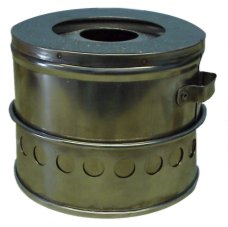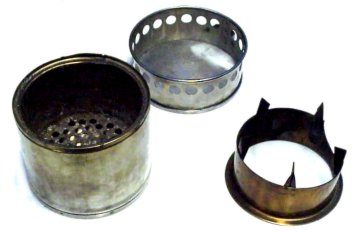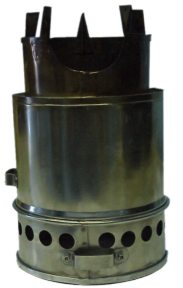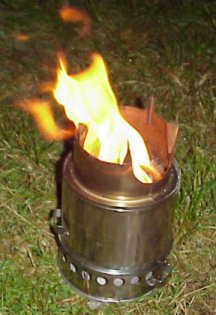This stove was designed to provide the cooking needs of one or two
people, but can also serve the needs of a family or small group if two
or more stoves are carried. Weighing 1 lb 4oz. and nesting inside of most
1.6 litre pots, it is well suited to the needs of the backpacker, cyclist,
and other outdoor travellers. Because it burns wood, it is a very economical
stove to use. There is no need to carry your fuel with you wherever wood
is available, making it useful for long trips, or when travelling in remote
areas where liquid fuels may not be available.
Under good conditions (protected from the wind and rain and with a lid on the pot) the Trek Stove can boil a quart of water in six to seven minutes. It is a very efficient stove which will consume only one pound of wood per hour at maximum heat, and uses even less at reduced heat. You will find that by using only dry wood and adding it a regular intervals so that the fire does not die down too much, you can keep a fire going and produce no smoke. It is made of a high quality 18% chrome 8% nickel stainless steel with some aluminium parts for many years of trouble free use.
|
How to use the Trek Stove: |
To assemble:
remove the base from the stove and place it on the ground with the
ring of holes uppermost. Place the firebox on the base, and remove the
windscreen/pot support from within the firebox, invert it, and place it
on top of the stove. 

Where to set up: The stove will not perform well in windy conditions, so set it up in a sheltered area or create a windbreak. The stove can be moved to a new location while it is still burning using a pot gripper or a pair of gloves.
The Trek Stove can be placed directly on a wooden surface such as an outdoor picnic table and will not scorch it in ordinary use (grossly overloading the stove can cause scorching). If you burn charcoal instead of wood, put a layer of sand in the base of the stove to protect the tabletop, because less cooling air is drawn through the bottom of the stove. If you set up the stove on the ground, clear an area at least three feet in diameter of flammable materials like grass or leaves because the fire sometimes tosses out sparks.
Do not use the stove indoors unless you have a means of venting the exhaust gases to the outdoors, for example a tepee.
To start the fire: Use only dry wood.
When other firestarting materials are not available, make three or four
short "fuzz sticks" with your knife. Also collect a handful
of small dry twigs or split some fine kindling. Light one of the fuzz
sticks and place it in the firebox so that the flames will climb up the
shavings. Place the other fuzz sticks around this, and add the kindling.
As the fire blazes up, continue to feed it with twigs or small pieces
of wood cut to about 3 ½" long. The fire will burn best if
you split anything over 1" in diameter in half, larger pieces into
quarters or smaller. An easy way to cut the short pieces of wood needed
is to place the wood over a root or log and nick each side with a small
axe, then hit the end with the poll of the axe to break it off. Large
diameter pieces of wood can be split first and then broken into short
pieces. Twigs, chips, roots, bark and pinecones all make good fuel if
they are dry. Under rainy conditions anything lying on the ground is likely
to be too damp; the lower dead branches of living trees are often the
driest wood available in rainy weather. If in doubt about the availability
of good dry wood at the campsite, collect a couple of pounds along the
trail when the opportunity arises and take it with you.
Cooking: a frying pan or pot can be placed directly on the five-point support of the windscreen. Wood can be fed to the fire through the opening on the side of the windscreen without removing the pot. With a little experience, the heat can be fairly well controlled by regulating the amount of wood added to the fire. To cook something that needs long simmering, to reduce the risk of burning the food, suspend the pot a little above the stove. One of the simplest ways to do this is by using the traditional "dingle stick" (a stick jammed into the ground at a angle, with a rock or log placed in the angle formed with the ground). The pot is hung on the end of the stick, and can be raised or lowered by adjusting the position of the supporting rock or log. If you have a very large pot or bucket to heat, two stoves can be placed under the suspended pot.
To sterilize water: If you are unsure of the safety of your water supply, boiling it for ten minutes will kill any micro-organisms. Boiling will not protect you from chemical contamination.
Clearing the firebox of ash, and other tips: After the Trek Stove has been burning for some time, ash buildup in the firebox may begin to impede the flow of air to the fire, reducing heat output. To cure this problem, use a stick to stir the charcoal, causing the ashes to fall through the grate. Or, use a pot gripper to lift the firebox and shake the ashes into the base.
If the firebox becomes overloaded with charcoal, stir or shake to clear the ash buildup, but do not add more wood until the charcoal burns down to a reasonable level. Overloading the stove with too much wood in an effort to make a very hot fire is one of the causes of the firebox clogging with charcoal. The other main cause is using unsplit pieces of wood that are too big, which produce large pieces of charcoal that will burn more slowly than smaller pieces.
Your pot will become blackened in use above a wood fire. You can help minimize the blackening by rubbing your pots with hand soap before using them. Then, washing up is quite a simple matter. Store the Trek Stove inside a closely woven bag so that it will not dirty the rest of your equipment. A thin pair of cotton gloves or leather work gloves carried with the tool kit will help to keep your hands clean when handling the blackened pot. They are also nice to have on cold mornings.
Using the Trek Stove as a campfire: In
moderate weather, the stove makes a great alternative to an open campfire,
providing light, warmth and cheer while consuming a minimal amount of
wood. Perhaps you have heard the old Indian dictum: "white man heap
fool: make um big fire - can't git near: Injun make um little fire - git
close. Uh, good!!"
Safety: Because the Trek Stove burns wood, there is a hazard of starting a forest fire if you do not carefully put out the fire when you are done. Dump any charcoal left in the stove out onto bare earth, and thoroughly drench it with water before you leave the campsite. If you are carrying the stove inside a pot, you can be on your way without waiting for the stove to completely cool, since the pot will protect the rest of your equipment.
Fritz Handel. www.trekstov.com |
 Contact us
Contact us